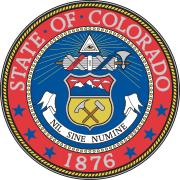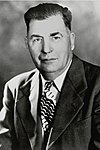The Democratic Senatorial Campaign Committee (DSCC) is the Democratic Hill committee for the United States Senate. It is the only organization solely dedicated to electing Democrats to the United States Senate. The DSCC's current Chair is Senator Gary Peters of Michigan, who succeeded Nevada‘s Catherine Cortez Masto after the 2020 Senate elections. DSCC's current Executive Director is Scott Fairchild.

The 1964 United States Senate elections coincided with the election of President Lyndon B. Johnson by an overwhelming majority, to a full term. His Democratic Party picked up a net two seats from the Republicans. As of 2022, this was the last time either party has had a two-thirds majority in the Senate, which would have hypothetically allowed the Senate Democrats to override a veto, propose constitutional amendments, convict and expel certain officials, or invoke cloture without any votes from Senate Republicans. In practice, however, internal divisions could have prevented the Democrats from doing so. The Senate election coincided with Democratic gains in the House in the same year.

The 1954 United States Senate elections was a midterm election in the first term of Dwight D. Eisenhower's presidency. Eisenhower's Republican party lost a net of two seats to the Democratic opposition. This small change was just enough to give Democrats control of the chamber with the support of an Independent who caucused with them.

Edwin George Perlmutter is an American lawyer and politician serving as the U.S. representative for Colorado's 7th congressional district. A member of the Democratic Party, his district is located in the northern and western suburbs of the Denver metropolitan area. He previously served as the Colorado state senator from the 20th district from 1995 to 2003. On January 10, 2022, he announced he would not seek re-election in 2022.
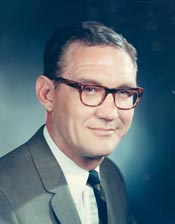
Donald Glenn Brotzman was a U.S. Representative from Colorado.
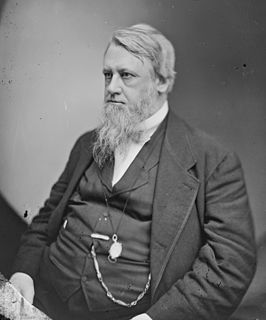
The 1868 and 1869 United States Senate elections were elections which had the Republican Party maintain their majority in the United States Senate. However, six former Confederate states were also readmitted separately from the regular election, each electing two Republicans. This increased the Republicans' already overwhelming majority to the largest proportion of seats ever controlled by the party.

The 2016 United States elections were held on Tuesday, November 8, 2016. Republican nominee Donald Trump defeated Democratic former Secretary of State Hillary Clinton in the presidential election, while Republicans retained control of Congress. This marked the first time Republicans won or held unified control of the presidency and Congress since 2004.
The following is a timeline of major events leading up to, during, and after the 2016 United States presidential election. The election was the 58th quadrennial United States presidential election, held on November 8, 2016. The presidential primaries and caucuses were held between February 1 and June 14, 2016, staggered among the 50 states, Washington, D.C., and U.S. territories. The U.S. Congress certified the electoral result on January 6, 2017, and the new President and Vice President were inaugurated on January 20, 2017.

The 2016 United States presidential election in Colorado was held on Tuesday, November 8, 2016, as part of the 2016 United States presidential election in which all 50 states plus the District of Columbia participated. Colorado voters chose electors to represent them in the Electoral College via a popular vote, pitting the Republican Party's nominee, businessman Donald Trump, and running mate Indiana Governor Mike Pence against Democratic Party nominee, former Secretary of State Hillary Clinton, and her running mate Virginia Senator Tim Kaine. Colorado has nine electoral votes in the Electoral College.

The 2016 United States presidential election in Vermont was held on November 8, 2016, as part of the 2016 United States presidential election in which all 50 states plus the District of Columbia participated. Vermont voters chose three electors to represent them in the Electoral College via a popular vote pitting the Republican Party's nominee, businessman Donald Trump, and running mate Indiana Governor Mike Pence against Democratic Party nominee, former Secretary of State Hillary Clinton and her running mate, Virginia Senator Tim Kaine. Independent Vermont Senator Bernie Sanders received unsolicited write-in votes.
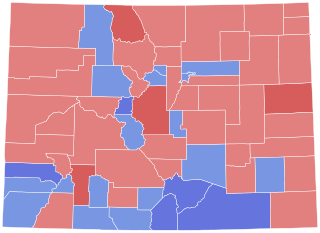
The 1956 Colorado gubernatorial election was held on November 6, 1956. Democratic nominee Stephen McNichols defeated Republican nominee Donald G. Brotzman with 51.34% of the vote.

The 1936 Colorado gubernatorial election was held on November 3, 1936. Democratic nominee Teller Ammons defeated Republican nominee Charles M. Armstrong with 54.57% of the vote.

The 1934 Colorado gubernatorial election was held on November 6, 1934. Incumbent Democrat Edwin C. Johnson defeated Republican nominee Nathan C. Warren with 58.11% of the vote.

The 1932 Colorado gubernatorial election was held on November 8, 1932. Democratic nominee Edwin C. Johnson defeated Republican nominee James D. Parriott with 57.23% of the vote.

The 1926 Colorado gubernatorial election was held on November 2, 1926. Democratic nominee Billy Adams defeated Republican nominee Oliver Henry Shoup with 59.84% of the vote.

The 1912 South Dakota gubernatorial election was held on November 5, 1912. Incumbent Republican Governor Robert S. Vessey declined to run for re-election to a third term. Lieutenant Governor Frank M. Byrne won the Republican primary to succeed Vessey, and then faced State Senator Edwin S. Johnson, the Democratic nominee, in the general election. Byrne only narrowly defeated Johnson, winning just 49% of the vote to Johnson's 46%, the closest gubernatorial election since 1898.

Elections were held in Illinois on Tuesday, November 3, 1936.

A general election was held in the U.S. state of Wyoming on Tuesday, November 7, 1922. All of the state's executive officers—the Governor, Secretary of State, Auditor, Treasurer, and Superintendent of Public Instruction—were up for election. Democrats improved considerably from their performances in 1918, with William B. Ross winning the gubernatorial election and almost all of their statewide candidates outpacing their 1918 nominees. However, Republicans held all of the other statewide offices.

The 1944 Missouri lieutenant gubernatorial election was held on November 7, 1944. Democratic nominee Walter Naylor Davis defeated Republican nominee James G. Blaine with 50.85% of the vote.

The 1952 North Carolina lieutenant gubernatorial election was held on November 4, 1952. Democratic nominee Luther H. Hodges defeated Republican nominee Warren H. Pritchard with 67.67% of the vote.

